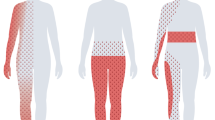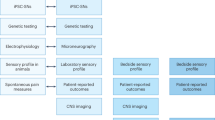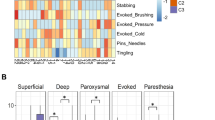Abstract
Classification of neuropathic pain according to etiology or localization has clear limitations. The discovery of specific molecular and cellular events following experimental nerve injury has raised the possibility of classifying neuropathic pain on the basis of the underlying neurobiological mechanisms. Application of this approach in the clinic is problematic, however, owing to a lack of precise tools to assess symptoms and signs, and difficulties in correlating symptoms and signs with mechanisms. Development and validation of diagnostic methods to identify mechanisms, together with pharmacological agents that specifically target these mechanisms, seems to be the most logical and rational way of improving neuropathic pain treatment.
Key Points
-
Classification of neuropathic pain on the basis of disease or location has considerable shortcomings, and an approach based on disease mechanisms might provide a viable alternative
-
To develop an effective mechanism-based classification, we need to be able to relate symptoms and signs to mechanisms, and to identify specific treatments for specific mechanisms
-
One mechanism might give rise to different symptoms and signs; for example, upregulation of sodium channels in C-fibers increases fiber activity, resulting in burning pain, paroxysms and dynamic mechanical allodynia
-
Similarly, one symptom or sign can be caused by several initiating mechanisms; for example, cold allodynia can be attributed to different mechanisms in peripheral and central neuropathic pain
-
It is becoming clear that we have not yet obtained a viable mechanism-based classification for neuropathic pain, and more-rigorous studies are required to test this approach
This is a preview of subscription content, access via your institution
Access options
Subscribe to this journal
Receive 12 print issues and online access
$209.00 per year
only $17.42 per issue
Buy this article
- Purchase on Springer Link
- Instant access to full article PDF
Prices may be subject to local taxes which are calculated during checkout

Similar content being viewed by others
References
McQuay and Moore (1998) An evidence based resource for pain relief. Oxford: Oxford University Press
Finnerup NB et al. (2005) Algorithm for neuropathic pain treatment: an evidence based proposal. Pain 118: 289–305
Baron R (2006) Mechanisms of Disease: neuropathic pain—a clinical perspective. Nat Clin Pract Neurol 2: 95–106
Jensen TS and Baron R (2003) Translation of symptoms and signs into mechanisms in neuropathic pain. Pain 102: 1–8
Farrar JT et al. (2001) Clinical importance of changes in chronic pain intensity measured on an 11-point numerical pain rating scale. Pain 94: 149–158
Rasmussen PV et al. (2004) Symptoms and signs in patients with suspected neuropathic pain. Pain 110: 461–469
Bouhassira D et al. (2005) Comparison of pain syndromes associated with nervous or somatic lesions and development of a new neuropathic pain diagnostic questionnaire (DN4). Pain 114: 29–36
Bennett M (2001) The LANSS Pain Scale: the Leeds assessment of neuropathic symptoms and signs. Pain 92: 147–157
Krause SJ and Backonja M (2003) Development of a neuropathic pain questionnaire. Clin J Pain 19: 306–314
Perkins FM et al. (2004) Development and validation of a brief, descriptive Danish pain questionnaire (BDDPQ). Acta Anaesthesiol Scand 48: 486–490
Rasmussen PV et al. (2004) Therapeutic outcome in neuropathic pain: relationship to evidence of nervous system lesion. Eur J Neurol 11: 545–553
Besson JM (1999) The neurobiology of pain. Lancet 353: 1610–1615
Julius D and Basbaum AI (2001) Molecular mechanisms of nociception. Nature 413: 203–210
Watkins LR et al. (2001) Spinal cord glia: new players in pain. Pain 93: 201–205
Mantyh PW et al. (2002) Molecular mechanisms of cancer pain. Nat Rev Cancer 2: 201–209
Scholz J and Woolf CJ (2002) Can we conquer pain? Nat Neurosci 5 (Suppl): S1062–S1067
Dubner R (1991) Neuronal plasticity in the spinal and medullary dorsal horns: a possible role in central pain mechanisms. In Pain and central nervous disease: the central pain syndromes, 143–155 (Ed Casey KL) New York: Raven Press
Hunt SP and Mantyh PW (2001) The molecular dynamics of pain control. Nat Rev Neurosci 2: 83–91
Hill R (2000) NK1 (substance P) receptor antagonists—why are they not analgesic in human? Trends Pharmacol Sci 21: 244–246
Goldstein DJ et al. (2001) Dose–response study of the analgesic effect of lanepitant in patients with painful diabetic neuropathy. Clin Neuropharmacol 24: 16–22
Sindrup SH et al. (2005) The NK1 receptor antagonist TKA731 in painful diabetic neuropathy. A randomised controlled trial. Eur J Pain [10.1016/j.ejpain.2005.08.001]
Fields HL (1990) Pain syndromes in neurology, 286. London: Butterworths
Jensen TS et al. (2001) The clinical picture of neuropathic pain. Eur J Pharmacol 429: 1–11
Koltzenburg M (1998) Painful neuropathies. Curr Opin Neurol 11: 515–521
Hansson P et al. (2001) Aspects of clinical and experimental neuropathic pain: the clinical perspective. In Neuropathic pain: pathophysiology and treatment, progress in pain research and management, vol 21, 1–18 (Eds Hansson P et al.) Seattle: IASP Press
Woolf CJ and Max MB (2001) Mechanism-based pain diagnosis: issues for analgesic drug development. Anesthesiology 95: 241–249
Jorum E et al. (2003) Cold allodynia and hyperalgesia in neuropathic pain: the effect of N-methyl-D-aspartate (NMDA) receptor antagonist ketamine—a double-blind, cross-over comparison with alfentanil and placebo. Pain 101: 229–235
Coderre TJ and Katz J (1997) Peripheral and central hyperexcitability: differential signs and symptoms in persistent pain. Behav Brain Sci 20: 404–419
Woolf CJ (2004) Dissecting out mechanisms responsible for peripheral neuropathic pain: implications for diagnosis and therapy. Life Sci 74: 2605–2610
Scholz J et al. (2005) Blocking caspase activity prevents transsynaptic neuronal apoptosis and the loss of inhibition in lamina II of the dorsal horn after peripheral nerve injury. J Neurosci 10: 7317–7323
Le Bars D et al. (1992) Diffuse noxious inhibitory controls (DNIC) in animals and in man. Patol Fiziol Eksp Ter 1992 Jul–Aug: 55–65
Porreca F et al. (2002) Chronic pain and medullary descending facilitation. Trends Neurosci 25: 319–325
Ren K and Dubner R (2002) Descending modulation in persistent pain: an update. Pain 100: 1–6
Hansson PT and Dickenson AH (2005) Pharmacological treatment of peripheral neuropathic pain conditions based on shared commonalities despite multiple etiologies. Pain 113: 251–254
Leung A et al. (2001) Concentration–effect relationship of intravenous alfentanil and ketamine on peripheral neurosensory thresholds, allodynia and hyperalgesia of neuropathic pain. Pain 91: 177–187
Otto M et al. (2003) Pain phenomena and possible mechanisms in patients with painful polyneuropathy. Pain 101: 187–192
Max MB et al. (1987) Amitriptyline relieves diabetic neuropathy pain in patients with normal or depressed mood. Neurology 37: 589–596
Sindrup SH et al. (2003) Venlafaxine versus imipramine in painful polyneuropathy: a randomized, controlled trial. Neurology 60: 1284–1289
Fields HL et al. (1998) Postherpetic neuralgia: irritable nociceptors and deafferentation. Neurobiol Dis 5: 209–227
Rowbotham MC et al. (1996) Cutaneous innervation density in the allodynic form of postherpetic neuralgia. Neurobiol Dis 3: 205–214
Rowbotham MC and Fields HL (1996) The relationship of pain, allodynia and thermal sensation in post-herpetic neuralgia. Brain 119: 347–354
Petersen KL et al. (2000) Capsaicin evoked pain and allodynia in post-herpetic neuralgia. Pain 88: 125–133
Torebjork HE et al. (1992) Central changes in processing of mechanoreceptive input in capsaicin-induced secondary hyperalgesia in humans. J Physiol 448: 765–780
Gracely RH et al. (1992) Painful neuropathy: altered central processing maintained dynamically by peripheral input. Pain 51: 175–194
Koltzenburg M et al. (1992) Dynamic and static components of mechanical hyperalgesia in human hairy skin. Pain 51: 207–219
Woolf CJ and Salter MW (2000) Neuronal plasticity: increasing the gain in pain. Science 288: 1765–1769
Nurmikko T and Bowsher D (1990) Somatosensory findings in postherpetic neuralgia. J Neurol Neurosurg Psychiatry 53: 135–141
Baron R and Saguer M (1995) Mechanical allodynia in postherpetic neuralgia: evidence for central mechanisms depending on nociceptive C-fiber degeneration. Neurology 45 (Suppl 8): S63–S65
Loeser JD et al. (1968) Chronic deafferentation of human spinal cord neurons. J Neurosurg 29: 48–50
Nakata Y et al. (1979) Supersensitivity to substance P after dorsal root section. Life Sci 24: 1651–1654
Basbaum AI and Wall PD (1976) Chronic changes in the response of cells in adult cat dorsal horn following partial deafferentation: the appearance of responding cells in a previously non-responsive region. Brain Res 116: 181–204
Rowbotham MC and Fields HL (1989) Topical lidocaine reduces pain in post-herpetic neuralgia. Pain 38: 297–301
Attal N et al. (1999) Effects of single and repeated applications of a eutectic mixture of local anaesthetics (EMLA) cream on spontaneous and evoked pain in post-herpetic neuralgia. Pain 81: 203–209
Rowbotham MC et al. (1995) Topical lidocaine gel relieves postherpetic neuralgia. Ann Neurol 37: 246–253
Rowbotham MC et al. (1996) Lidocaine patch: double-blind controlled study of a new treatment method for post-herpetic neuralgia. Pain 65: 39–44
Wasner G et al. (2005) Postherpetic neuralgia: topical lidocaine is effective in nociceptor-deprived skin. J Neurol 252: 677–686
Herrmann DN et al. (2005) Skin biopsy and quantitative sensory testing do not predict response to lidocaine patch in painful neuropathies. Muscle Nerve [10.1002/mus.20419]
Finnerup NB et al. (2002) Lamotrigine in spinal cord injury pain: a randomized controlled trial. Pain 96: 375–383
Attal N et al. (2004) Systemic lidocaine in pain due to peripheral nerve injury and predictors of response. Neurology 62: 218–225
Finnerup NB et al. (2005) Intravenous lidocaine relieves spinal cord injury pain: a randomized controlled trial. Anesthesiology 102: 1023–1030
Wasner G et al. (2003) Complex regional pain syndrome—diagnostic, mechanisms, CNS involvement and therapy. Spinal Cord 41: 64–75
Raja SN et al. (1991) Systemic alpha-adrenergic blockade with phenolamine: a diagnostic test for sympathetically maintained pain. Anesthesiology 74: 691–698
Arner S (1991) Intraveneous phentolamine test: diagnostic and prognostic use in reflex sympathetic dystrophy. Pain 46: 17–22
Rowbotham MC et al. (1991) Both intravenous lidocaine and morphine reduce the pain of postherpetic neuralgia. Neurology 41: 1024–1028
Baranowski AP et al. (1999) A trial of intravenous lidocaine on the pain and allodynia of postherpetic neuralgia. J Pain Symptom Manage 17: 429–433
Attal N et al. (2000) Intravenous lidocaine in central pain: a double-blind, placebo-controlled, psychophysical study. Neurology 54: 564–574
Wallace MS et al. (2000) Concentration–effect relationship of intravenous lidocaine on the allodynia of complex regional pain syndrome types I and II. Anesthesiology 92: 75–83
Meier T et al. (2003) Efficacy of lidocaine patch 5% in the treatment of focal peripheral neuropathic pain syndromes: a randomized, double-blind, placebo-controlled study. Pain 106: 151–158
Wallace MS et al. (2000) Efficacy of oral mexiletine for neuropathic pain with allodynia: a double-blind, placebo-controlled, crossover study. Reg Anesth Pain Med 25: 459–467
Vestergaard K et al. (2001) Lamotrigine for central poststroke pain: a randomized controlled trial. Neurology 56: 184–190
Eide PK et al. (1994) Relief of post-herpetic neuralgia with the N-methyl-D-aspartic acid receptor antagonist ketamine: a double-blind, cross-over comparison with morphine and placebo. Pain 58: 347–354
Eide PK et al. (1995) Central dysesthesia pain after traumatic spinal cord injury is dependent on N-methyl-D-aspartate receptor activation. Neurosurgery 37: 1080–1087
Felsby S et al. (1996) NMDA receptor blockade in chronic neuropathic pain: a comparison of ketamine and magnesium chloride. Pain 64: 283–291
Max MB et al. (1995) Intravenous infusion of the NMDA antagonist, ketamine, in chronic posttraumatic pain with allodynia: a double-blind comparison to alfentanil and placebo. Clin Neuropharmacol 18: 360–368
Attal N et al. (2002) Effects of IV morphine in central pain: a randomized placebo-controlled study. Neurology 58: 554–563
Watson CP and Babul N (1998) Efficacy of oxycodone in neuropathic pain: a randomized trial in postherpetic neuralgia. Neurology 50: 1837–1841
Watson CP et al. (2003) Controlled-release oxycodone relieves neuropathic pain: a randomized controlled trial in painful diabetic neuropathy. Pain 105: 71–78
Sindrup SH et al. (1999) The effect of tramadol in painful polyneuropathy in relation to serum drug and metabolite levels. Clin Pharmacol Ther 66: 636–641
Canavero S and Bonicalzi V (2004) Intravenous subhypnotic propofol in central pain: a double-blind, placebo-controlled, crossover study. Clin Neuropharmacol 27: 182–186
Yucel A et al. (2005) The effect of venlafaxine on ongoing and experimentally induced pain in neuropathic pain patients: a double blind, placebo controlled study. Eur J Pain 9: 407–416
McAdoo DJ et al. (1999) Changes in amino acid concentrations over time and space around an impact injury and their diffusion through the rat spinal cord. Exp Neurol 159: 538–544
Gwak YS and Hulsebosch CE (2005) Upregulation of Group I metabotropic glutamate receptors in neurons and astrocytes in the dorsal horn following spinal cord injury. Exp Neurol 195: 236–243
Liu J et al. (2004) Peripherally delivered glutamic acid decarboxylase gene therapy for spinal cord injury pain. Mol Ther 10: 57–66
Hains BC et al. (2003) Upregulation of sodium channel Nav1.3 and functional involvement in neuronal hyperexcitability associated with central neuropathic pain after spinal cord injury. J Neurosci 23: 8881–8892
Author information
Authors and Affiliations
Corresponding author
Ethics declarations
Competing interests
The authors declare no competing financial interests.
Rights and permissions
About this article
Cite this article
Finnerup, N., Jensen, T. Mechanisms of Disease: mechanism-based classification of neuropathic pain—a critical analysis. Nat Rev Neurol 2, 107–115 (2006). https://doi.org/10.1038/ncpneuro0118
Received:
Accepted:
Issue Date:
DOI: https://doi.org/10.1038/ncpneuro0118
This article is cited by
-
Tweety-Homolog 1 Facilitates Pain via Enhancement of Nociceptor Excitability and Spinal Synaptic Transmission
Neuroscience Bulletin (2021)
-
Analgesic Action of Invasive Carboxytherapy: Mechanisms and Applications
Neurophysiology (2021)
-
Neuropathic pain
Nature Reviews Disease Primers (2017)
-
How to diagnose neuropathic pain? The contribution from clinical examination, pain questionnaires and diagnostic tests
Neurological Sciences (2015)
-
Reappraising neuropathic pain in humans—how symptoms help disclose mechanisms
Nature Reviews Neurology (2013)



